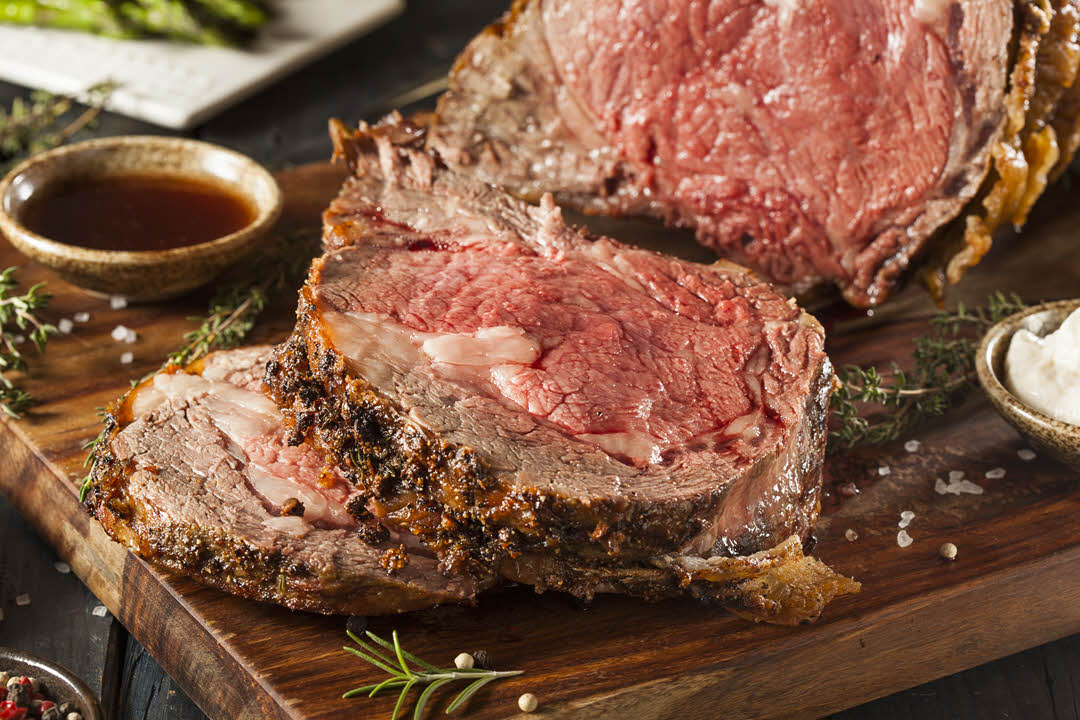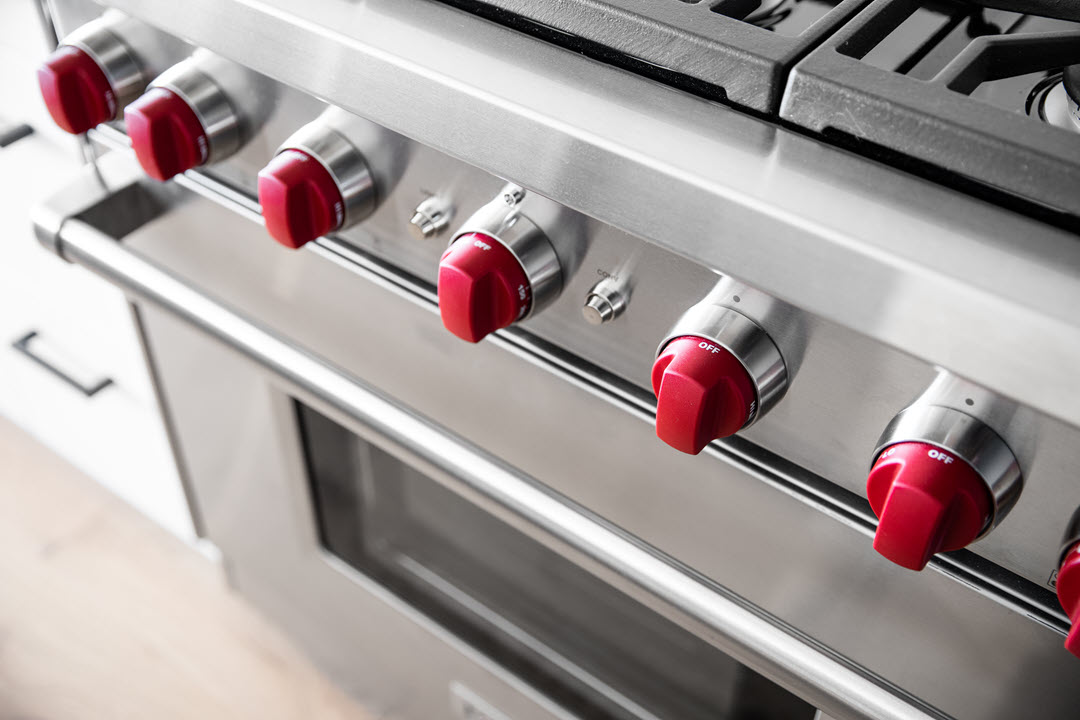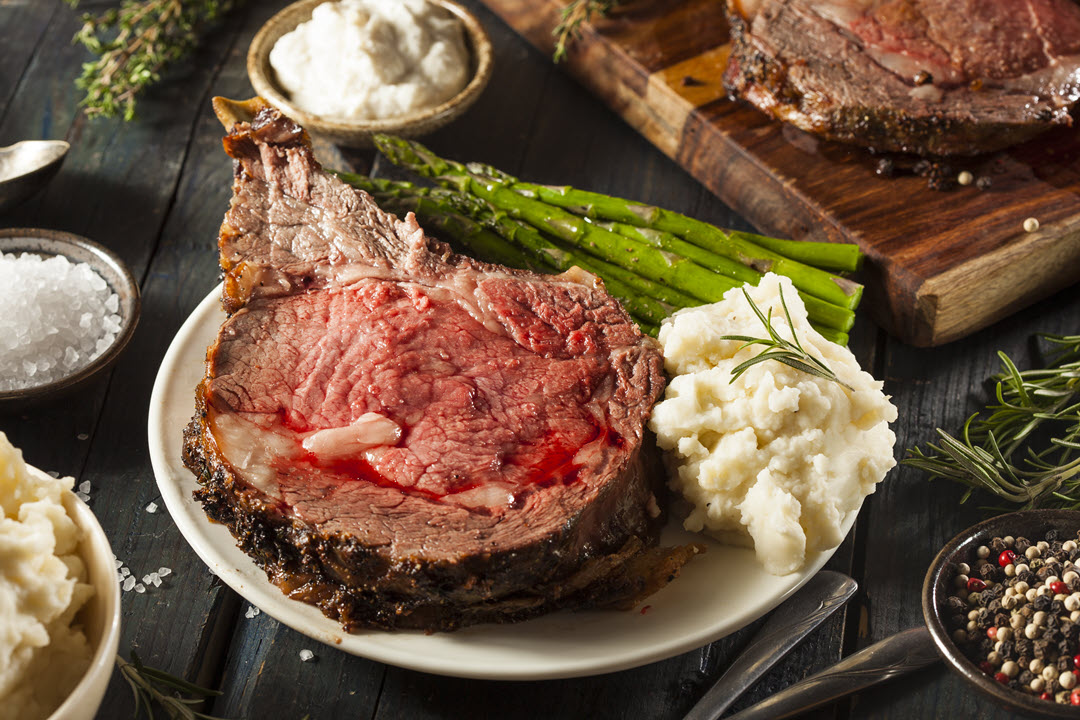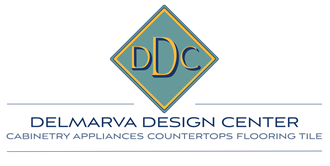How to Cook a Delicious Meal at Home!

A Meal That is Always Center Stage
Prime rib often claims center stage during the holiday season for good reason. It is the king of beef cuts and makes a delicious and impressive meal. A bone-in prime rib roast is also called a standing rib roast because you can position the roast majestically on its rib bones in the roasting pan to cook it.
A prime rib is beautifully marbled with fat; this roast is rich, juicy, and tender—a feast for the eyes and your taste buds.
As noted above, nothing beats the taste of a perfectly cooked prime rib steak. This classic steak may be intimidating to some. However, learning how to cook prime rib will be worth it as it makes for a wonderful meal with family and friends.
A Wolf oven can be a prime tool for cooking a delicious prime rib. More on this later as there is a very thoughtful video at the end of this post with tips on how to make a wonderful home-cooked prime rib dinner.
What You Will Need
- A 6-pound bone-in rib steak (or boneless rib steak, if preferred). A rib roast is the most common cut of steak used for prime rib. It is considered “prime” because it is cut from the cow’s best and most tender parts of the rib section.
- A roasting pan with a rack. When cooking, place the rack in the center of the pan.
- A meat thermometer (highly recommended) to ensure the steak is done to perfection.
- A cutting board that is large enough to accommodate the size of your prime rib.
- Tongs and large cutting knife.
What To Buy – Bone In or Bone Out?
You can choose to buy your prime rib bone-in or boneless. Many prime-rib experts say bone-in ribs are more flavorful and cook better. Either version will be wonderful, so the choice is up to you.
If you buy a boneless prime rib, you will want to set it on a rack to roast. I’ve succeeded in using the wire rack from my instant pot set on top of my cast iron skillet.
Special Prime Rib Note:
Note that just because you are ordering a “prime” rib doesn’t mean you are getting USDA Prime. Because of high cost and fewer sources over the past decade or two, USDA Prime Grade prime rib has been replaced in most markets with USDA Choice Grade prime rib roast.
Most “prime ribs” we get from the market are USDA Choice quality. This is a very good cut of beef.
If you want USDA Prime prime rib, which has more fat marbling throughout the meat and can easily cost 50 percent more per pound, you may need to place a special order with your butcher.

A Wolf Oven with Classic Red Knobs
Preparing the Prime Rib
Now it is time to salt the prime rib. We recommend salting the prime rib early while waiting for it to come up to room temperature (perhaps 2-3 hours). The salt will have time to diffuse into the prime rib by salting early.
Your prime rib will have a bold and flavorful taste without the salt being too overpowering. You want the salt taste to be subtle but present in the meat.
Why salt your prime rib?
- It amplifies flavor
- It can affect the texture of the beef depending on when the salt is applied
- You want a steak to be salted but not to taste salty
- A well-salted steak will enable us to experience it as juicier because salt stimulates our saliva flow

Cooking
Prime rib is a very nice cut of meat, and the internal temperature is easy to measure with a good meat thermometer. Don’t leave the internal temperature to be by chance. Shoot for the internal temperature to match the level of doneness you like.
Prime rib is best served rare or medium rare. Once it’s overcooked, you can’t un-cook it, though you can wait for it to cook a little longer.
This internal temperature guide will help you get your prime rib right (so delicious!).
For a rare roast: 115°F.
For medium rare: 120°F.
For a medium: 130°F.
Let it sit for 15 to 20 minutes before serving. The internal temperature will rise 5 to 10 degrees as the prime rib roast rests.
Brown Your Prime Rib
To start, brown the roast at a high temperature. Set the oven to 500°F (or as high as your oven will go) for 15 minutes.
Lower the oven to 325°F to finish roasting. Roast in the oven until the thermometer registers 115°F for rare or 120° for medium rare and 130°F for medium.
To estimate the total cooking time, allow about 11 to 12 minutes per pound for rare and 13 to 15 minutes per pound for medium rare. The actual cooking time will depend on the shape of the roast, how chilled your roast still is when it goes into the oven, and your particular oven.
Note: A flatter roast will cook more quickly than a thicker one. A chilled roast will take more time than one closer to room temp.
Check the temperature of the roast using a meat thermometer an hour before you expect the roast to be done.
For example, with a 10-pound roast, you would expect 2 hours of cooking time for rare. This time includes is the sum of the 15 minutes at 500° and 1 3/4 hours at 325°.
Therefore, check after 1 hour 15 minutes of total cooking time, or 1 hour after you lowered the oven temp to 325°. If you use a remote thermometer, you can continually monitor the internal temperature, which is a big advantage to using this type of thermometer.
Final Touches – Rest
Remove the prime rib and let it rest before serving. The prime rib will continue to cook even after it has been removed from your oven. Let it rest for 15-20 minutes. While it is resting, pour the drippings from the pan into a small bowl and serve the drippings as a sauce.
Serve the sliced prime rib with your favorite side dishes and enjoy!
Tips for Perfect Prime Rib
Start at Room Temperature
Remove your prime rib from the refrigerator one hour before cooking.
Season it on all sides with salt and cover it loosely with plastic wrap as it comes to room temperature. Prime rib roast will cook better and more evenly when your starting temperature is room temperature.
Use a Meat Thermometer!
You can use a probe that stays inside the meat the entire time it cooks or a simple instant-read meat thermometer. Either way, remember that each slice of meat is different, and each oven is different. Don’t take the chance of ruining such an expensive piece of meat.
Don’t Over-Cook!
The meat will continue to cook once it’s taken out of the oven (your thermometer will continue to rise 5-10 degrees) so err on the side of taking your prime rib out early. If you take it out and it seems undercooked, you can cook it a little longer.
Let It Rest!
As with most meat, you want to let it rest after cooking to allow the juices to settle in the meat, making it juicier and more tender. If you cut into your prime rib without letting it rest, the juices will rush out, and the meat will be chewy.
Cut Your Prime Rib Across the Grain.
That means noticing the directional lines in the meat grain and slicing perpendicular to them. If you cut along the grain, the meat will be tougher and chewier.
Cut your prime rib into ½-inch thick slices.
A Wolf Oven in Gourmet Mode
The wolf oven can make all the decisions for you. Prime rib settings are programmed into the oven. The oven has a probe, and the oven will monitor the internal temperature. Also, no preheating is necessary.
Wolf has worked with many chefs. Wolf has tapped their knowledge so that your Wolf oven can make all the proper decisions about cooking your prime rib roast to perfection!
1. Put Your Wolf Oven Into Gourmet Mode
2. Select the Prime Rib Program
3. Define the final internal temperature (rare or medium rare, for example)
4. The oven will both brown and slow-cook your prime rib
5. The result will be a perfect prime rib with uniform color edge-to-edge
Video content provided by Wolf
Conclusion
Nothing compares to a perfectly cooked prime rib steak. Follow these easy steps to make a mouth-watering meal at home. With careful preparation and the right ingredients, you can create an unforgettable prime rib steak that is sure to impress your guests. These tips will help you make the perfect prime rib steak.
The next step up will be to let your Wolf Oven do the cooking for you!
The DDC Kitchen Design Team has extensive experience in these five key product areas.
Cabinetry • Appliances • Countertops • Flooring • Tile
The DDC Kitchen Design Team has extensive experience in these five key product areas.
Cabinetry • Appliances • Countertops • Flooring • Tile
The Delmarva Design Center
A kitchen range is an essential appliance for your kitchen. It is where the cooking of delicious meals for your family happens. There is a wide variety of sizes, types, and brands. Wolf makes an excellent series of ranges and ovens. Stop by the Delmarva Design Center in Selbyville, Delaware, to learn about all the advantages of the Wolf series of ovens and ranges.
Visit the Delmarva Design Center at 38507 Dupont Boulevard in Selbyville, Delaware, to see our wide selection of kitchen cabinets, appliances, countertop materials, and flooring.
